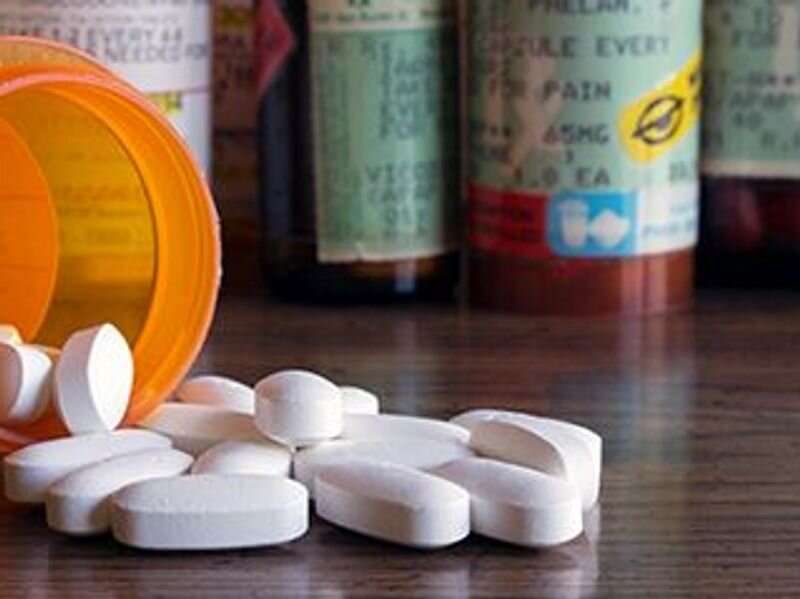Did pandemic lockdowns worsen the epidemic of opioid abuse?

(HealthDay)—Pandemic lockdowns may have led fewer Americans to seek pain treatment last year, but folks who did seek help had higher-than-usual odds of receiving dangerous opioid painkillers, a new study says.
And that could lead to a worsening of the opioid epidemic, researchers suggest.
"It is likely that more patients may have become addicted to opioids than would have been the case absent the pandemic," said study lead author Byungkyu Lee, an assistant professor of sociology at Indiana University Bloomington.
Lee and his team tracked treatment patterns for millions of patients struggling with limb, extremity, joint, back and/or neck pain. They found that prescriptions for highly addictive opioid medications like oxycodone (OxyContin) rose 3.5% during the first half-year of the pandemic compared with the prior year—despite a 16% plummet in pain diagnoses.
That may be because, in the face of lockdowns, doctors were less likely to turn to nonmedicinal treatments such as massage therapy and other forms of "complementary medicine" like acupuncture and osteopathy. Scripts for such approaches fell by 6% during the same time frame.
"One reason for rising opioid prescriptions during the pandemic is lack of access to non-pharmacologic treatments that require person-to-person contact," explained Lee.
"Prescribing opioids for pain is a faster and easier 'no-contact' solution than physical therapy or complementary medicine," he noted. "Opioids can be prescribed through telemedicine, for example."
The findings were published Dec. 10 in JAMA Network Open, just weeks after U.S. health officials reported drug overdose deaths in the United States increased dramatically during the pandemic—jumping nearly 30% from April 2020 to April 2021 compared to the prior 12-month period.
In the new study, the investigators examined data from two time periods: January through September 2019 and January through September 2020 (including the first six months of the pandemic).
About 21 million patients were included in each period. In all, the analysis covered about a fifth of Americans with commercial insurance across all 50 states and roughly a quarter of all Medicare Advantage patients, the authors said.
Investigators compared prescription patterns from April to September of each year.
Not only were there higher opioid prescription rates during the pandemic, but they were at higher doses—roughly equivalent to an additional 1.0 morphine milligrams. Also, prescriptions were written for more than one day longer, on average, than pre-pandemic.
However, Lee said it's too soon to say if these prescription shifts will prove long-lasting.
One pain expert said we should not lose focus on other forms of treating chronic pain.
"Over-reliance on opioids during the pandemic may provide a challenge going forward," noted Dr. Yili Huang, director of pain management at Northwell Health's Phelps Hospital in Sleepy Hollow, N.Y.
"However, the major concern here is how do we ensure that we do not lose access to important pain treatments during a pandemic," said Huang, who was not involved in the study.
Lee noted that nonopioid options "will likely continue to be inaccessible for many patients because of factors such as cost, underinsurance, lack of transportation, lack of child care, or inability to take time off work." In practical terms, he said, that means Black and Hispanic patients, poorer patients and those in rural regions will remain less likely to receive non-drug-based alternatives.
Huang, meanwhile, struck an optimistic note, suggesting "the narrative and understanding of the role of opioids is changing.
"Patients and their providers are looking for appropriate safe alternatives to treat their pain," he noted, adding telemedicine may help in that regard.
"I think we can learn to leverage telehealth to connect patients with quality pain care like never before," even including physical therapy via the internet, Huang said.
"There are always certain aspects that require in-person treatment, such as pain procedures," he said. "But telehealth can help bridge the divide."
More information: There's more on the opioid crisis at the U.S. Centers for Disease Control and Prevention.
Byungkyu Lee et al, Substitution of Nonpharmacologic Therapy With Opioid Prescribing for Pain During the COVID-19 Pandemic, JAMA Network Open (2021). DOI: 10.1001/jamanetworkopen.2021.38453
Copyright © 2021 HealthDay. All rights reserved.





















